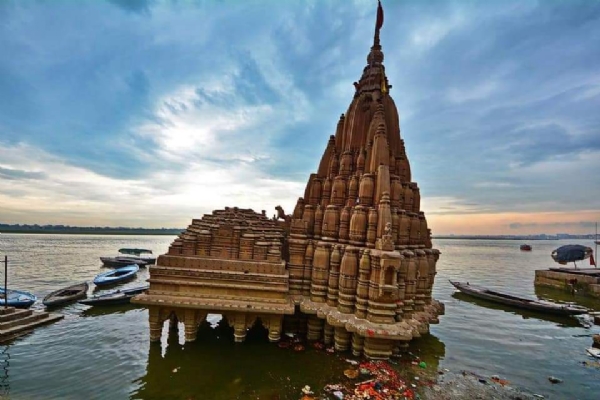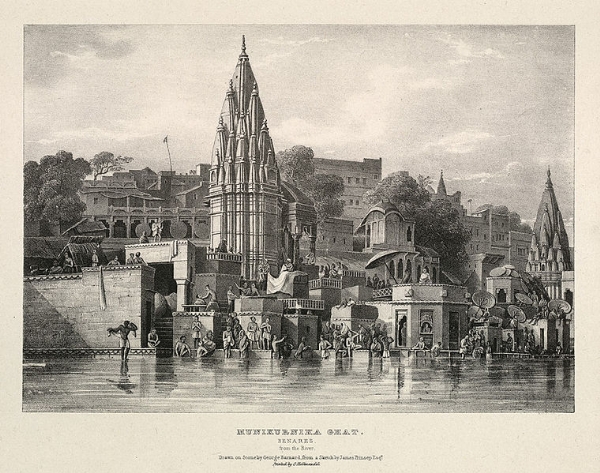Ratneshwar Mahadev Temple: the enigma of Varanasi
The temple is also known as ‘Kashi Karvat’ because it leans at 9 degrees.
Total Views |
At the banks of the Ganges in Varanasi, lays India’s own version of the Leaning Tower of Pisa. This is the Ratneshwar Mahadev Temple, one of the only two leaning temples in the world. The other one is the Leaning temple of Huma in Odisha. The tilt of the Varanasi shrine, at 9 degrees, is 5 degrees more than the incline of the Pisa.

Every little aspect about this temple is an enigma, which only adds up to its myths and theories but there are little to no answers available. According to one of the legends, the shrine was built by a servant of Raja Man Singh of Amer, while another myth says that it was built by a servant of Ahilya Bai Holkar. Another one claims that it built by Scindia queen of Gwalior, Baiza Bai, in the 19th century.
According to a local legend, the tilt of the temple is because of a curse. According to a legend, Raja Man Singh’s servant built this temple for his mother, Ratna Bai, and then proudly boasted to have successfully repaid the debt he owed her. It is said that a mother’s debt can never be repaid, hence, she cursed the temple. Subsequently, the temple started to lean. The shrine gets its alternative name ‘Matru-rin’ from this particular legend.
A brief look at the paintings from earlier times throws some light into the details of the temple. It looks like this temple wasn’t the only one that was built along the river then. Sketches from earlier times show a few other partially submerged temples, of which only this temple seems to have survived. In a few of the earlier paintings, the Ratneshwar temple seems to be upright and not titled at all. This suggests that it began to lean in the 20th century. A weak / defective foundation and the pressure put on by the river’s currents may have caused the temple to start tilting.

He wrote, “The octagonal mut’h towards the right hand, marks the south corner of Ahulya Basee’s ghat; one of the niches outside is embellished with a small white marble figure of this celebrated princess in a sitting posture. She caused the two temples represented in the sketch to be erected, on the site of others, which had been carried away by the river.

The Ratneshwar Mahadev Mandir was built in about 1825. This temple is dedicated to Lord Shiva and is unique in many ways. The temple is located near Manikarnika Ghat on the banks of the Ganga. The temple is also known as ‘Kashi Karvat’ because it leans at 9 degrees. Some experts say the temple has been designed in this way, but the findings are not conclusive. Photos taken in about 1860 do not show any lean.
The temple is built right on the waterfront, at the bottom of the stunning Manikarnika Ghat, and the temple is partially submerged year-round. At times, waters of the Ganges rise quite high, covering a part of the shikara / main tower of the temple. When the temple entrance is below the water, the priest dives into the water to perform the puja.
Ratneshwar Mahadev Temple draws a lot of attention from pilgrims visiting the holy city of Varanasi.
— Raghu (@IndiaTales7) August 1, 2020
Did You Know?
The temple was built extremely close to the Ganges River & has developed a 9 degree slant. By contrast, the Leaning Tower of Pisa in Italy tilts just 4 degrees!! pic.twitter.com/HQikJC3AkT
The temple is an elegant structure designed in the classical style. For the most part, the sanctum is underwater. Enshrined in the sanctum of the temple is a Shivling made of stone.
Every little aspect about this temple is an enigma, which only adds up to its myths and theories but there are little to no answers available. According to one of the legends, the shrine was built by a servant of Raja Man Singh of Amer, while another myth says that it was built by a servant of Ahilya Bai Holkar. Another one claims that it built by Scindia queen of Gwalior, Baiza Bai, in the 19th century.
According to a local legend, the tilt of the temple is because of a curse. According to a legend, Raja Man Singh’s servant built this temple for his mother, Ratna Bai, and then proudly boasted to have successfully repaid the debt he owed her. It is said that a mother’s debt can never be repaid, hence, she cursed the temple. Subsequently, the temple started to lean. The shrine gets its alternative name ‘Matru-rin’ from this particular legend.
Also Read | Shri Mangeshi temple: The 4 centuries-old beauty of Goa representing typical Goan Hindu style of architecture
Edwin Greaves described the temple in his book Kashi the City Illustrious or Benares (1909) “Looked at from the river, there is in the centre the dense crowds of people on the footway by Manikarnika Kund, as the background to these, a strange medley of temples and buildings with the red-domed temple of the Raja of Amethi towering above them all; in the foreground a leaning temple and porch, almost on a level with the water, and threatening to topple over into it, and the eager crowds of bathers from various parts, in their various styles of dress, and exhibiting a variety of colouring.”
A brief look at the paintings from earlier times throws some light into the details of the temple. It looks like this temple wasn’t the only one that was built along the river then. Sketches from earlier times show a few other partially submerged temples, of which only this temple seems to have survived. In a few of the earlier paintings, the Ratneshwar temple seems to be upright and not titled at all. This suggests that it began to lean in the 20th century. A weak / defective foundation and the pressure put on by the river’s currents may have caused the temple to start tilting.

More evidence is seen in Benares Illustrated, In a series of Drawings by English Scholar James Prinsep, and Assay Master at the Benares Mint from 1820 to 1830. During this, he made and published a series of sketches.
He wrote, “The octagonal mut’h towards the right hand, marks the south corner of Ahulya Basee’s ghat; one of the niches outside is embellished with a small white marble figure of this celebrated princess in a sitting posture. She caused the two temples represented in the sketch to be erected, on the site of others, which had been carried away by the river.
Also Read | Padmanabhaswamy temple: the true treasure of South India!
The same fate seems to threaten the new structures also at no very distant period, as the whole strength of the stream is exerted to undermine them. In the rains, the temples are submerged to the cornice; many Hindoos, notwithstanding, are bold enough to swim through an impetuous current, and to dive under the porch and door-way, for the honour of continuing their customary worship in despite of perils and personal inconvenience.” Even though the temple is underwater for a lot of the year, it is still well preserved.


